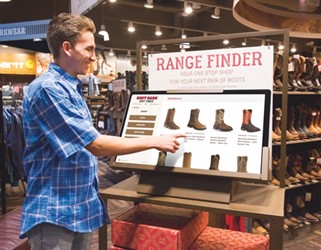Future-Proofing Your Tech Purchases With A Mobile OS And Unified Architecture
By Raimon Chikhani, Director of Sales, Elo

Nearly every consumer carrying a smartphone has used a mobile application for ordering, purchasing, product reviews or other productivity applications. Now mobile technology is driving unprecedented change in the restaurant and retail industries as the foundation for future enterprise architectures increasing the flexibility and simplicity of new technology innovation. As companies continue to invest in a mobile-first approach for consumer-facing applications, they increasingly understand the value a unified mobile architecture creates in centralizing development efforts and increasing synergy of application frameworks from kiosk to kitchen.
Companies who invest in mobile-first customer experiences, without implementing a unified mobile architecture approach may waste precious time and money using consumer-grade mobile products, leading to a continual swapping out of outdated platforms and hardware. To break this perpetual rip-and-replace cycle, companies need to find a smarter way to deploy new commercial devices.
The secret to future-proofing devices is to invest in scalable, flexible solutions that evolve with the company and end user. This is achieved via a unified mobile architecture built on Android. Installing a common platform across all environment touchpoints will streamline your ecosystem, allow IT to be more efficient, and shorten new application deployment time as business and consumer needs evolve.
Ensuring that your next technology investment utilizes a mobile architecture will eliminate the risk of the solution depreciating in value over time. The way your ecosystem is designed significantly impacts how flexible your hardware can be and, most importantly, how long your investment will last. A secure, flexible, predictable and manageable mobile Android architecture across all devices will ensure the rollout is effective, consumer-friendly and more adaptable long-term.
A Proof Of Concept Brings Confidence To Future Deployment
With any new solution, businesses should consider implementing the best practice of a proof-of-concept (PoC) and testing the technology in a small number of strategic locations before replicating across their larger network. Taking the technology for a trial run enables businesses to prove the value before investing further. If that technology you trial is built on a flexible, scalable architecture, you can be confident what you’re testing is representative of every device in your ecosystem independent of the specific use case, making scalability simple. You have to be confident the same technology deployed for your initial PoC can scale quickly across the entire business, for both consumer-facing and employee-facing applications, without issue. This flexibility is a key value a unified mobile operating system provides.
Taco Bell, for example, recently piloted self-service interactive kiosks in a few select regions across the nation. When the PoC showed clear benefits, the restaurant chain was able to quickly and seamlessly roll out to 1,200 stores within 3 months. This was made possible with a PoC using a unified mobile architecture ecosystem. Now, Taco Bell is able to control all solutions at every restaurant on one common platform, with zero-touch deployment — making implementation across the large chain fast and easy. And with future growth, Taco Bell and other businesses like it have the versatility to get technology at new locations up and running in an instant. This enabled Taco Bell to roll out the centrally managed platform to their 7,000 restaurants in less than 18 months.
Common Architecture Enables Flexibility
To paint a picture of mobile architecture’s flexibility, imagine customers in line to check out with a retailer when not all of the POS stations are staffed. Shoppers get frustrated by the delay, but instead of panicking, store associates easily transform the unstaffed POS stations into temporary self-checkouts. This is made possible by a unified mobile architecture that enables all the interactive applications in the physical environment on demand. The line continues moving, customers are satisfied, and retailers can be more flexible with their staffing models.
Companies who do have a unified mobile architecture can seamlessly create strong employee and customer experiences across a variety of applications given the architecture’s fluidity. It also makes it simple for the IT team to debug and resolve issues across multiple devices, because everything is on one common architecture.
Hardware Is Kept Versatile
A unified mobile architecture also brings the benefit of repurposing owned hardware as needs evolve — the architecture remains the same and serves as the foundation for future-use cases. This is a huge advantage as business needs can shift quickly. Using existing hardware to add additional capabilities and peripherals saves a lot of time and money, but only if the architecture is built to support it from the start.
For example, a touch screen that was once self-service could easily be repurposed as a kitchen automation tool or POS system. Lifestyle retailer Boot Barn initially used touch screens as a product-locator kiosk, but with the unified architecture in place, they’re now leveraging the kiosks for other purposes like employee training, in-store returns and brand advertisements. The hardware remains the same while the unified Android architecture creates new opportunities for interaction. The ability to add additional capabilities and keep your hardware versatile will future-proof your purchase, adapting to whatever your customers demand next.
Organizations should take advantage of mobile architecture to prepare for what’s ahead. Aligning your consumer, employee and logistics all onto one secure mobile platform affords companies the flexibility, scalability and reliability needed for future success. By laying the groundwork for a successful future, businesses will be able to focus on offering fun and efficient experiences that keep customers coming back for more.
About The Author
Raimon Chikhani is Director of Sales for Elo.
